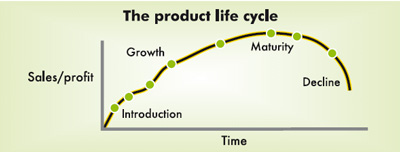When a product is introduced to the public the company knows it will not sell forever. Every product has a unique life cycle that is goes through, nobody knows exactly how long the product will spend in each stage. The goal of the product life cycle is to ensure that enough profit is made to cover all of the effort and risk it took to get the product launched (Kotler and Armstrong, 2014). Below is a break down of what each stage entails.
Introduction Stage
This is the first stage of the life cycle. It happens when the product is first launched to the public. In this period growth and sales are slow. In addition, profits are negative because there is only money going out for promotion and expenses while slow income is being made.
Growth Stage
This is the second stage of the life cycle. This comes after the product has satisfied the market (Kotler and Armstong, 2014). In this stage sales are rapid and growth happens quickly. This is also the point where competition will enter the market. Profits are higher in this stage because expenses are more evenly distributed. In addition, a company can take time to enhance the product and add distribution channels in this stage.
Maturity Stage
This is the third stage of the life cycle. This is the longest stage of the cycle. Sales begin to slow but remain steady here. In addition, competition is lowering prices and increasing advertising. This means that in order to be successful a company needs to modify it’s product to meet consumer needs. A company will also try to market to new segments or re create a need for the product to present customers.
Decline Stage
This is the last stage in the life cycle. Sales become slow, in some cases they can drop to zero. However, many products continue to sale at a low level for many years. This stage can cost a company a lot of money so a firm has to make the decision on whether to keep producing the product or drop it completely. A company can choose to maintain the brand where it re positions it and hopes to go back towards the growth stage. They can also harvest the product where they cut costs and hope sales stay steady. Lastly, they can completely drop the product by liquidating its favorable assets or selling them off.
Sources
Kotler, P. & Armstrong, G. (2014). Principles of Marketing. Upper Saddle River, NJ: Pearson Education, Inc.

